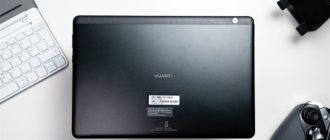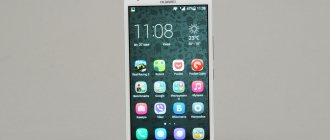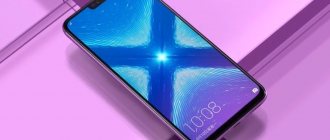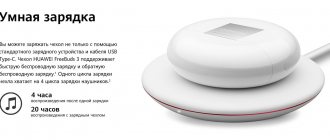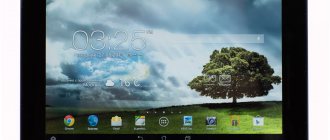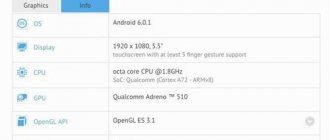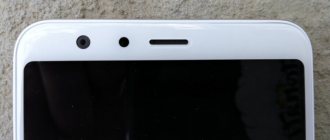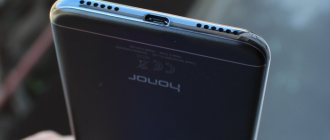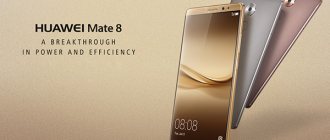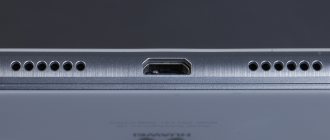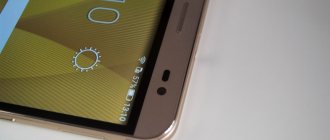09:28 2018-03-12 / Ivan Kushch / Test reviews of equipment
Despite the general decline in interest in tablets, low-priced models continue to be in demand. Our today's hero, the 8-inch tablet Huawei MediaPad T3, belongs exactly to this class of devices. Its cost does not exceed 10,500 rubles, and its functionality is easily enough for reading news, e-books, watching movies and running undemanding games. Such devices are referred to as “strong budget phones.” It remains to test it in practice.
The class of inexpensive tablets with 7- and 8-inch screens continues to be in demand. This is largely due to the compact size of the devices and their practicality for schoolchildren and students. The gadget can easily be used as an e-reader or a screen for watching movies and TV series on the go. As a result, many manufacturers are trying to release their model with decent characteristics at the lowest price. One example is Huawei MediaPad T3 8.0.
Among the characteristics of the tablet, it is worth noting a metal body, a small thickness of 7.95 mm, a bright screen and a capacious battery. In addition, the new product received a Qualcomm Snapdragon 425 processor, 2 GB of RAM, 16 GB of internal memory, and LTE support. The device can be used for telephone conversations over a cellular network. The main camera is 5 megapixels, the front camera is 2 megapixels each.
Technical specifications of Huawei MediaPad T3 (model KOB-L09)
| Characteristic | Description |
| Operating system: | Android 7.0 with EMUI 5.1 shell |
| Screen: | IPS-LCD, 8 inches, resolution 1280×800, recognition of up to ten simultaneous touches, protective glass with oleophobic coating |
| CPU: | Quad-core Qualcomm Snapdragon 425 (4 A53 cores × 1.4 GHz) |
| GPU: | Qualcomm Adreno 308 |
| RAM: | 2 GB |
| Flash memory: | 16 GB |
| SIM card type: | one – nanoSIM |
| Mobile connection: | support 2G/3G/4G (LTE800, LTE1800, LTE2600), phone calls, SMS |
| Communications: | 802.11 a/b/g/n (2.4 GHz and 5.0 GHz), Bluetooth 4.0, microUSB connector, 3.5 mm audio jack |
| Navigation: | GPS, A-GPS, GLONASS, BEIDOU |
| Sensors: | Proximity sensor, accelerometer/gyroscope, magnetometer (digital compass) |
| Main camera: | 5 MP, autofocus, f/2.2, no flash |
| Front-camera: | 2 megapixels without autofocus |
| Battery: | non-removable, 4800 mAh |
| Dimensions, weight: | 211 x 125 x 7.95 mm, 350 g |
| Materials: | Plastic, aluminum, glass |
Review of the budget tablet Huawei MediaPad T3 7 and its improved version with 3G support
3 years ago November 17, 2020 at 01:35 pm 12746
What do people most often use Android tablets for? How many users need the real performance of its processor and video core? Do they regularly run resource-intensive 3D games and applications on mobile hardware? For example, a car mechanic simulator? Who uses a tablet as a full-fledged alternative to a camera and why does it cope with this role better than the camera of the same smartphone? For whom can a tablet really replace a work laptop in use cases directly related to doing work, and not surfing on social networks and watching videos on YouTube that are in no way related to the task? How many different features and functions available in our mobile devices do we almost never use? Fingerprint scanner? Gyroscope? 20 MP front camera? Eight processor cores operating at the highest possible frequency? But you have to pay for all this from your wallet!
Many tablet users just want to see a mobile device, with a relatively compact size with a relatively large display diagonal, convenient for playing video content, allowing you to surf the Web, communicate through applications and “pop balloons” in simple but addictive (and time-killing) games. yes) casual games!
1
It is for such use cases that the Huawei MediaPad T3 7 tablet is designed, which belongs to the MediaPad T3 line and is a simple, compact and affordable solution in the entry-level segment with a 7-inch screen diagonal. Yes, the MediaPad T3 7 is interesting primarily for its low price - 5190 rubles in official stores. But at the same time, the new product has a high-quality display and a metal body 8.6 mm thick, although with an insert of rough plastic of very average quality in the upper part of the rear panel. But the latter prevents the micro USB and 3.5 mm plugs from scratching the aluminum case. In any case, a budget product from a well-known Chinese company with a worldwide reputation looks much more interesting than a bunch of frankly mediocre “nonames” from the same price range, buying which we risk encountering a number of problems, including mediocre build quality, materials and components, instability software performance, unreliability and fragility of the device, poor service support, etc.
This tablet is positioned by the manufacturer primarily as an affordable solution for undemanding users who need to access the Internet, use applications for communicating on social networks, etc. In this material I will share my personal impressions of its two-week use.
MediaPad T3 7, the youngest model in the MediaPad T3 line, is equipped with a 7-inch IPS display with a resolution of 1024×600 pixels. The tablet is based on the MediaTek MT8127 processor, consisting of 4 ARM Cortex - A7 cores operating at a clock frequency of up to 1.3 GHz and 1 GB of RAM. Mali-450 MP is responsible for graphics. The built-in storage capacity is 8 GB, with about 3.5 GB available to the user, but microSD memory cards with a capacity of up to 128 GB are supported. True, they are inserted in a somewhat unusual way - by turning the tablet towards you with the back side and opening the high-quality and tight-fitting plug of the corresponding slot, the memory card must be inserted, turning it towards you not with the front side, but with the side on which the contact pads are located. Yes, it looks somewhat unexpected and it was only on the second or third attempt that I understood why the card did not want to go into the slot.
Both cameras, the main and front ones, have a modest 2 MP resolution and fixed focus. On the other hand, even more advanced cameras on significantly more expensive tablets still often lose in picture quality to cheap cameras.
The tablet runs Android 6.0 OS with the proprietary EMUI 4.1 interface. There is a “children’s” mode that allows you to run only selected applications.
The tablet uses a built-in lithium-polymer battery with a capacity of 3000 mAh, its charge is enough for a day of active work.
Testing the tablet's performance in the AnTuTu application showed the following results:
In total, the tablet with the factory index BG2-W09 received 27371 points.
Of them:
3D 1967 (for the Garden test, the Sediment test did not start)
UX 10600
CPU 9832
RAM 4972
3
One of the main disadvantages of the standard version of MediaPad T3 7 is the inability to connect to the Internet via mobile communications, only via Wi-Fi. Unfortunately, free access to Wi-Fi networks is not available everywhere, which significantly limits the use of a tablet as a device for accessing the Internet. The rest of the time, the device turns into a high-quality device for reading pdf files or a multimedia player on Android. Well, or it makes it possible to play the most simple and graphically uncomplicated games.
Another unpleasant thing was that the tablet does not support many applications necessary for the functioning of various devices connected via Bluetooth. For example, I was unable to install applications for the Honor Band A1 fitness bracelet and the Oral-B Genius smart toothbrush.
4
Also, it should be noted that when actively surfing websites and running several applications at the same time, performance noticeably sags. Alas, some “slowness” of the tablet compared to product samples belonging to the middle price segment is obvious.
By the way, once I accidentally launched the service menu when turning it on - it is written in Chinese, which is very inconvenient in terms of diagnosing and servicing the device outside an authorized service center.
But before I had time to finish and submit this material to the editor, I received a press release from Huawei in the mail, which announced that an improved version of the MediaPad T3 7 had been released with support for 3G communications, which will allow access to the Internet in those places where where there are no open Wi-Fi hotspots. Moreover, the updated model exists in two modifications - with a built-in drive of a standard capacity of 8 GB and increased to 16 GB. In addition, for the 3G versions of the tablet, the operating system was updated to Android 7.0 with the EMUI 5.1 graphical shell (instead of Android 6.0 / EMUI 4.1 for the standard version). They also use a larger built-in battery with a capacity of 4100 mAh, instead of 3000 mAh in the standard version. It is noted that the 3G version with an 8 GB drive is available in a gold body color in addition to the standard gray. The updated MediaPad T3 7 with a 3G module became available from October 16, 2020 in the retail networks MTS, Svyaznoy, M.Video and DNS.
My overall verdict would be this. The standard version of MediaPad T3 7 is suitable for the most undemanding users and those who, for some reason, need an inexpensive but high-quality Android device, as a “children’s” tablet (especially since the corresponding mode is supported), a tablet for a schoolchild (for study, and not for games). The tablet is best suited as a budget solution for multimedia: watching movies, videos, reading books and magazines in .pdf format, and for fans of simple casual games. But it’s better not to run games with advanced 3D graphics on it. It will also not support some applications that require various sensors, which this tablet does not have. Including applications for various “smart” gadgets. As a device for accessing the Internet, the standard version without a 3G module can only function in semi-stationary mode, only where there is access to Wi-Fi. And this must first be taken into account when purchasing. But the improved versions with 3G support are devoid of this significant limitation and already look much more interesting, including due to the use of a newer version of the operating system with the EMUI graphical shell and a battery capacity increased by a quarter. But for users who are more demanding of device performance, or those who want a tablet with a larger display diagonal, it makes sense to pay attention to the “older” models of the MediaPad T3 line with display diagonals of 8 and 10 inches.
Characteristics:
Display: 7-inch IPS display with a resolution of 1024×600 pixels
Operating system: Android 6.0 OS with EMUI 4.1 interface for the “standard” version (without 3G support) and Android 7.0 OS with EMUI 5.1 interface for versions with 3G support
Processor: 4-core A7 processor with a clock frequency of 1.3 GHz
RAM: 1 GB
Internal storage: 8 GB or 16 GB – optional for 3G version
Communication standards: Wi-Fi 802.11 a/b/g/n 2.4G&5G, for versions with 3G support – built-in 3G module
microSD card support: up to 128 GB
Battery capacity: 3000 mAh for the “standard” version (without 3G support) and 4100 mAh for versions with 3G support
Thickness: 8.6 mm
Weight: 250 g
Price: 5,190 rubles for the standard version (without 3G support), 5,990 rubles for the 3G version and 6,990 rubles for the 3G version with built-in memory increased to 16 GB.
Delivery package and first impressions
The tablet comes in a thick cardboard box. At the top there is an inscription with the name of the model.
In addition to the device itself, the package contains a microUSB cable for synchronization and charging, an electrical adapter, a master key for the SIM card tray, instructions and a warranty card.
As for the tablet itself, it is compact and very thin. By the way, models with an 8-inch screen are the most convenient to use. They make it easy to read text information, websites, and watch movies comfortably. At the same time, the dimensions and weight are not as large as those of devices with a screen of 10 inches or more. The dimensions of Huawei MediaPad T3 8.0 are 211 x 125 x 7.95 mm, weight 350 grams.
The tablet can be grasped with one hand. Of course, you will have to control it with both hands. In general, I did not notice any shortcomings. You can choose a case to protect your tablet. Fortunately, in stores and on the Internet you can find many accessories of various price levels.
Advantages and disadvantages
The Huawei MediaPad 7 Classic tablet has the following advantages:
- Small size, modest design and durable body;
- High quality screen;
- High performance for this device segment;
- Great speaker.
Among the shortcomings, it is worth noting the brightness of the screen - compared to its competitors, the picture is a little dimmer. Based on the average cost, you should immediately assume that the tablet will not handle powerful games. In general, this model has no significant disadvantages; compared to other devices, it is more functional in terms of parameters.
Design and appearance
The design of Huawei MediaPad T3 8.0 is classic. The tablet is thin and compact with narrow frames on the sides. The body shape is rectangular, aspect ratio is 16:9, the corners are sloping, the edges taper on the sides. The design is monolithic, there are no removable parts.
The rear panel is made almost entirely of aluminum, which is painted in the color of the corresponding case. On sale you can find a black and silver version of the case. The metal looks great and gives the device reliability. In addition, it strengthens the structure, protects it from falls and mechanical damage. You can see plastic inserts at the top and bottom. Antennas for receiving and transmitting data from cellular networks, Wi-Fi, Bluetooth, GPS/GLONASS are located here.
The screen is protected by glass with an oleophobic coating. This coating is quite effective. The finger glides across the display easily, and any fingerprints that appear are erased quickly.
Above the screen you can see a speaker that plays calls, music, and telephone conversations. On the right is a 2 megapixel front camera. Light and position sensors are also located here. You can also see a dot LED that starts blinking when messages, emails, etc. arrive.
On the right side you can see the power/lock button and the volume key. A slot for a nanoSIM-type SIM card, as well as a slot for a microSD memory card, is located below.
On the bottom edge of the tablet there is a microUSB port, as well as a microphone for making calls. The 3.5 mm jack for connecting headphones is located on the top edge.
The back of the Huawei MediaPad T3 8.0 is made of aluminum, with the exception of the plastic upper and lower parts, under which the antennas and radio communication modules are located. The main camera lens is located almost in the very corner on top; it is slightly recessed into the body.
To sum up the appearance, we can say that the tablet has a pleasant appearance. There are no questions about the assembly, it is of high quality and reliable. In public transport, the MediaPad is extremely convenient for reading books and watching movies and TV series. It is small, quite light, and the 8-inch screen allows you to not strain your eyesight.
Design
The Huawei MediaPad 7 Classic tablet has a strict, classic and discreet design - the front is black, the back is made of aluminum and has a silver color. In addition to reliability - a metal surface can withstand damage much better than plastic; this solution looks more solid and expensive. The edges of the back panel are framed with black plastic, the camera is located on top, and the speaker is located below it - it’s worth noting right away that the placement is a little impractical, you will need to clean it from dust from time to time.
All side keys are placed conveniently and consistently, the connectors are located nearby and covered with a plug - this protects them from contamination and makes the overall appearance even neater.
In general, the design turned out to be practical; most users will like the design, since the tablet will look appropriate not only in a casual, but also in a business environment.
Screen. Graphics capabilities
Huawei MediaPad T3 8.0 is equipped with an 8-inch screen made using IPS technology without an air gap. The capacitive sensor supports up to 10 simultaneous touches. Resolution - 1280x800 (189 ppi). For its diagonal size, the resolution is frankly low. A closer look at the interface reveals individual pixels and angular fonts. You have to enlarge them a little for comfortable reading. But for watching video, the display is excellent; the low resolution no longer hurts the eyes. Thanks to the aspect ratio, the display is perfect for watching movies, TV series and other videos.
The viewing angles are not the greatest, but looking at the price of the device, you can make a discount. The maximum brightness level in the sun is not enough, the image fades outdoors.
The picture on the display looks adequate, with high contrast. In complete darkness, the brightness can be reduced to a comfortable value. The device does not have a light sensor, so the brightness will have to be set manually. But the settings have two useful functions: protection against ultraviolet radiation with the ability to turn on on a schedule and adjusting the color temperature of the display.
If we talk about the sensitivity of the screen, it responds well to touches and recognizes gestures without problems. But the reaction due to the thoughtful hardware is still not as fast as we would like.
The screen of the Huawei MediaPad T3 8.0 can be rated “satisfactory”.
Hardware platform: processor, memory, performance
MediaPad T3 8.0 is equipped with a 64-bit Qualcomm Snapdragon 425 chip with a quad-core processor - 4 Cortex A53 cores clocked at up to 1.4 GHz. Graphics subsystem (GPU) – Adreno 308. There is 2 GB of RAM, 16 GB of built-in file storage. You can expand the built-in memory using microSD cards. The device has a corresponding slot for this.
If we talk about the interface, it is unhurried. In most work scenarios, you will not notice any glitches or slowdowns, but the slowness will be visible. When several medium-sized applications are running in the background, the interface may fluctuate. The low speed of the built-in memory also makes itself felt: installing applications takes quite a long time.
The Adreno 308 video accelerator easily copes with drawing the interface, but is poorly suited for serious gaming. If you really want to play, set the minimum settings and launch almost any game. In this case, the RAM fills up instantly, so you can’t count on serious work; for this you need to buy more advanced tablet models.
Performance
The Huawei MediaPad 7 Classic tablet is equipped with a quad-core Qualcomm MSM8260 Snapdragon processor with a frequency of 1.2 GHz. What does this mean? This device guarantees high performance, fast operation of applications, browsers, and players. Games are another matter; they are heavy and resource-intensive programs that may not work correctly on a tablet.
But in everyday use, the processor shows its best side - when simultaneously surfing the Internet and running several applications, glitches and slowdowns were not observed in most cases.
Thanks to the high-quality Adreno 220 graphics processor, streaming video and Full HD files are played back without problems. Therefore, we can conclude that if you use a tablet to access the Internet, read books, watch movies and listen to music, or work with documents, it can easily cope with such tasks.
Communication capabilities
The tablet supports all modern communication networks: 2G/3G and 4G on Russian frequencies. The quality of signal reception is not satisfactory; the device confidently maintains communication indoors and does not lose the signal in areas of poor reception.
The device supports telephone calls over a mobile network. But constantly using it as a phone is not an option; it is intended for other tasks. To do this, it is more convenient to connect a headset and talk through it.
MediaPad T3 8.0 can work with all modern wireless networks. Among them are dual-band Wi-Fi 802.11 b/g/n, Wi-Fi Direct, you can organize a wireless access point via Wi-Fi or Bluetooth channels. All modules work quickly and without failures.
Among the additional communication tools, it is worth noting GPS, A-GPS, GLONASS, BeiDou (standard Google Maps cartography is built into the smartphone). The navigation error radius during testing was about 5 meters, which is very little. The gadget copes well with the role of a navigator. In addition, you can stream music from your tablet to your car speakers. Using it in this mode was much more convenient than using a telephone. Plus the smartphone remained charged.
It is worth remembering the external dynamics. There is only one in the tablet for conversations and multimedia. The volume is sufficient, but the quality is mediocre. But the placement on the front panel plays into its hands; while watching movies, the sound is directed specifically at the user. The situation is similar in headphones - the quality is quite expected and cannot boast of anything.
Duration of work
The tablet has a lithium-ion battery with a capacity of 4800 mAh. The tablet's battery life is good, but not outstanding. The battery capacity is average, and as a result, the results are average. In continuous reading mode, the device worked for 11 hours, in video viewing mode – about 5 hours.
With an average usage scenario (the Internet is turned on, browsing the Internet 3 hours a day, watching a movie for 2 hours a day, playing games for up to 30 minutes a day), the tablet worked for two days. These indicators are typical for many mid-level devices. There is no fast charging here, so be prepared for 3-4 hours of charging.
User Interface and Operating System
MediaPad T3 8.0 runs the original Android 7.0 operating system with Huawei's proprietary shell installed - EMUI 5.1.
All programs are displayed in one list on the main and adjacent screens.
In the settings of the MediaPad T3 8.0 there is an option for eye protection (it is turned on only during reading - the amount of blue color decreases, that is, the picture becomes warmer).
Among the pre-installed programs, it is worth noting Office from Microsoft, social network clients, file manager, FM radio.
Any other programs on the tablet can be installed from the Google Play store.
Hardware and software platform
The recipe for creating a good tablet is very simple - just take a high-quality screen, a productive platform with a capacious battery, and supplement this set with the current version of the OS. However, behind the apparent simplicity lies a number of problems, for example, it is quite difficult to find the optimal balance between the capacity of the built-in battery (and therefore the final autonomy) and the weight/thickness of the tablet, as well as to ensure an attractive price with a high level of equipment of the device.
Huawei MediaPad 10 FHD model is equipped with a high-quality 10-inch IPS matrix with Full HD resolution of 1920 by 1200 pixels. Of the Android tablets of this form factor, only a few models available in Ukraine can boast comparable screen parameters, in particular the Acer Iconia Tab A700 and ASUS Transformer Pad Infinity TF700T. The hardware platform used is the quad-core system-on-chip K3V2 (Hi3620), once developed by one of the divisions of Huawei, and now by a separate company HiSilicon. This SoC contains four ARM Cortex-A9 cores, 16 graphics cores and a 64-bit memory controller, the operating frequency can be from 1.2 to 1.5 GHz. System performance in synthetic benchmarks is quite high (see screenshots), but in real life, given the high resolution and not the most common processor, some applications may have problems (in particular, some games simply refused to launch). With a 6600 mAh battery, the tablet can work for about 8 hours in mixed mode (browsing, watching videos, playing games).
Please note that the tablet is available in two main modifications: S10-101w “only-Wi-Fi” and S10-101u with a 3G modem (LTE Cat4, DC-HSPA+), while in devices for European markets the operating frequency of the processor is 1 ,2 GHz, and the amount of RAM is 1 GB. A more powerful configuration with a 1.5 GHz processor and 2 GB of RAM is officially available only in Asian markets; if you wish, you can try to order it yourself.
Huawei MediaPad 10 FHD tablet runs Android OS 4.0.4, complemented by Huawei's proprietary software shell. The interface is so noticeably different from the standard one that you should carefully study the online help when you first try it. Already at the stage of unlocking the screen, you will see not only the time, but also calendar events, and by selecting the desired direction of swiping outside the “ring”, you can switch to message, camera or gallery mode. But the biggest surprise is the “absence” of the control panel, which can be hidden and pulled back by swiping from the bottom of the screen, similar to how it is done in the Modern UI from Windows 8. After this, you are no longer too surprised by the absence of an application section - shortcuts installed programs simply appear on desktops, where they are offered to be organized into groups and folders.
In general, I liked the software part of the Huawei MediaPad 10 FHD ; the interface, although not too familiar, is optimized for high resolution and looks great. Interestingly, when connected to a PC, the tablet is not recognized as an external storage medium and you have to use proprietary HiSuite software to transfer content, which is quite unusual for an Android tablet.
Camera. Photo and video capabilities
Huawei MediaPad T3 8.0 is equipped with two cameras. The main one is 5 megapixels, f/2.2, with autofocus. There is no flash. The camera is a typical budget camera. On the street, in good lighting, it takes more or less adequate pictures. But in difficult lighting, in rooms with difficult light, the photos turn out to be of poor quality. Focus is lost and the image is blurry, colors are unrealistic.
The main camera of the smartphone can record video with sound in the maximum FullHD resolution. The quality of the video can be rated as “C”. The video appears blurry in most cases.
I will also mention the front camera for selfies. It is 2 megapixels. The pictures don't come out very well either. In general, the cameras in this tablet are purely nominal. They don't make much sense.
